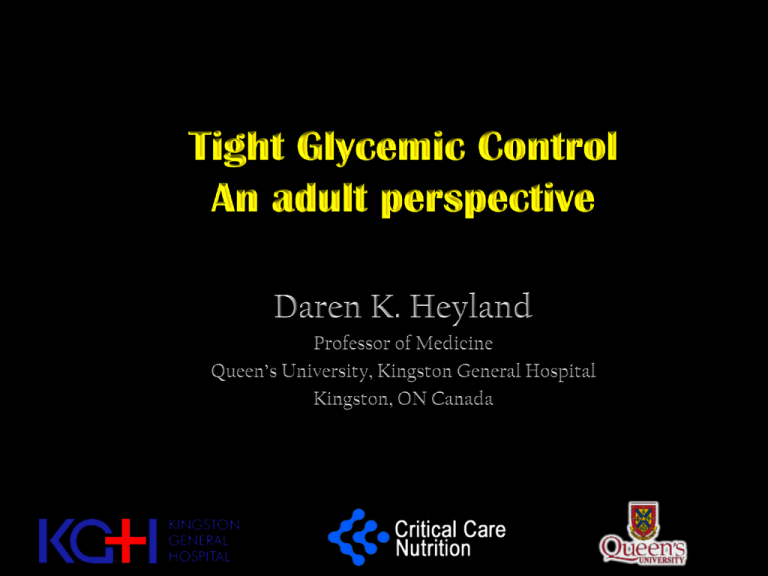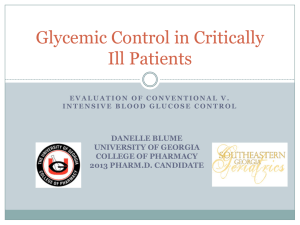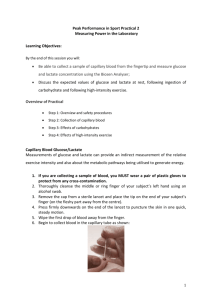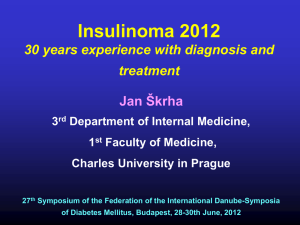TightGlycemicControl_CNW2010th
advertisement

• Mr PS • 76 years old • COPD, no DM • Severe CAP • Day 1- intubated, sedated, high o2 requirements, vasopressor dependent • Starting early EN • Glucose 11.1 mmol/L (200 mg/dl) What would you do? A. Start insulin infusion and titrate glucose to 4.4- 6.1 mmol/l B. Start insulin infusion and titrate infusion to 7-9 mmol/l C. Watchful waiting D. Don’t Know E. Don’t care Intensive Insulin Therapy Van den Berge NEJM 2001;345:1359 The Intensive Insulin Therapy Bandwagon What happened? • • • • Endorsed by National and International societies Recommend by clinical practice guidelines Standards for hospital accreditation Part of Institute for Healthcare Improvement and other quality improvement campaign TIGHT GLYCEMIC CONTROL • Clearly a difference in outcome • High mortality rate in control group? • Repeatability? • Interpretation of findings? • Generalizability of findings? Van den Berge NEJM 2001;345:1359 Feeding • All given IV glucose from day of admission Nutritional Strategy: Usual Practice? Canadian Recommendations Enteral vs. Parenteral Nutrition • Based on one level 1 and 12 level 2 studies, when considering nutrition support for critically ill patients, we strongly recommend the use of Enteral Nutrition over Parenteral Nutrition. www.criticalcarenutrition.com Canadian Recommendations Combined EN and PN • Based on 5 level 2 studies, for critically ill patients starting on enteral nutrition we recommend that parenteral nutrition not be started at the same time as enteral nutrition. www.criticalcarenutrition.com ASPEN/SCCM ICU Nutrition CPGs PN vs Standard Care • In the patient who was previously healthy prior to critical illness with no evidence of protein-calorie malnutrition, use of PN should be reserved and initiated only after the first 7 days of hospitalization (when EN is not available). Supplemental PN • If unable to meet energy requirements after 7-10 days by the enteral route, consider initiating PN. • Initiating PN prior to this 7-10 day period does not improve outcome and may be detrimental to the patient. McClave JPEN 2009;33:277 TIGHT GLYCEMIC CONTROL Harmed by glucose? Rescued by Insulin? Van den Berge NEJM 2001;345:1359 Reproducibility of the Original Protocol? • “If blood glucose is 40-60 mg/dl, stop the insulin infusion, assure adequate baseline glucose intake, and check the blood glucose level within the next hour.” • “If blood glucose approaches the normal range, reduce insulin by 25-50.” GENERALIZABILITY OF VAN DEN BERGHE’S INITIAL STUDY? • • • • • • Single center 1200 MICU patients Same protocol Control: 180-215 mg/dl ITT Group: 80-110 mg/dl Predominantly PN fed Mortality • Hypoglycemia rates higher in ITT: 18.7% vs 3.1% Intensive Insulin Therapy and Pentastarch Resuscitation in Severe Sepsis • 18 ICUs in Germany (SepNet) • Control: <180 mg/dl • ITT Group: 80-110 mg/dl • Predominantly enteral fed • 50% surgery • Suspended prematurely because of higher rate of hypoglycemia 40 35 30 25 Tight Control 20 15 10 5 0 28 day 90 day Mortality • Hypoglycemia rates higher in ITT: 12.1% vs 2.1% Brunkhorst NEJM 2008;358:125 A prospective multi-centre controlled trial on tight glucose control by intensive insulin therapy in adult intensive care units: The GLUCONTROL study • • • • 21 ICUs across Europe Control: 7.8 -10.0 mmol/L ITT group: 4.4-6.1 mmol/L Trials suspended early because of protocol violations • 1,101 patients randomized • 60% surgical/40% medical Mortality • Hypoglycemia rates higher in ITT: 8.7% vs 2.7%, p<0.001 Preiser JC Intensive Care Med 2009 NICE – SUGAR Study • Aim – to compare the effects of the two blood glucose targets on 90 day all-cause mortality • Hypothesis – The hypothesis is that there is no difference in the relative risk of death between patients assigned a glucose range of 4.5 - 6.0 mmol/L (81 – 108 mg/dl) and those assigned a glucose range of 10.0 mmol/L or less (180mg/dL or less) Inclusion Criteria • ICU treatment that extends beyond the calendar day after the day of admission (i.e. on three consecutive days). • Arterial catheter in situ (or imminent) • Consent has been / will be obtained Maximal Generalizability Severe hypoglycaemia (≤2.2mmol/L: ≤40mg/dL) Patients Intensive Glucose Control Conventional Glucose Control Odds ratio (95% CI) 206/3016 6.8% 15/3014 0.5% 14.7 (9.0 – 25.9) All reported and investigated as SAEs No long term sequelae reported © The NICE SUGAR Study Investigators 2009 P <0.001 Outcomes: Mortality Intensive Glucose Control Conventional Glucose Control Odds ratio (95% CI) Dead at 28 days 670/3010 22.3% 627/3012 20.8% 1.09 (0.96 - 1.23) P = 0.17 Dead at 90 days 829/3010 27.5% 751/3012 24.9% 1.14 (1.02 - 1.28) P = 0.02 1.14 (1.01 - 1.29) P = 0.04 Adjusted mortality at 90 days Adjusted for operative admission, geographic region, age, admission source, APACHE II score, mechanical ventilation © The NICE SUGAR Study Investigators 2009 Survival Hazard ratio 1.11 (conventional vs. ITT, p=0.03) © The NICE SUGAR Study Investigators 2009 Pre-defined subgroup pairs © The NICE SUGAR Study Investigators 2009 Conclusions of the Trial • A blood glucose target of 4.5 – 6.0 mmol/L resulted in increased mortality compared to a target of <10.0mmol/L. • In comparison with other trials, severe hypoglycaemia was relatively uncommon but significantly more common in those assigned to intensive glucose control. • On the basis of these results we do not recommend targeting normoglycaemia in critically ill adults. CMAJ 2009;180:821 Severe Hypoglycemia (SH) in Critically Ill Patients: Risk Factors and Outcomes • Observational study of >5000 ICU patients • 102 had at least 1 episode of glucose < 2.2 mmol (40 mg/dL) • Risk Factors: diabetes, septic shock, renal failure, mechanical ventilation, APACHE score and treatment with ITT. • SH independently associated with increased mortality 60 50 40 SH Control 30 20 10 0 ICU Employed Case-control matching Krinsley CCM 2007;35:2262 Intensive Insulin Therapy - Rate of Hypoglycemia (<40 mg/dl) 30 Conventional Intensive 25 p<0.001 20 % p<0.001 18.7 p<0.001 17.6 14.5 15 p<0.001 10 p<0.001 6.8 5.1 5 4.5 3.9 3.1 0.5 0.8 0 Van den Berghe, 2001 Van den Berghe (ITT), 2006 VISEP, 2008 NICE-SUGAR, 2009 GluControl, 2006 Kosiborad JAMA 2009:301:1556 Consider Glucose Variability? Ali CCM 2008;36:2316 Intensive Insulin Therapy Benefits Risks Workload Intensive Insulin Therapy Bandwagon Canadian Recommendations Intensive Insulin Therapy We recommend that hyperglycemia (blood sugars > 10 mmol/L) be avoided in all critically ill patients. Based on the NICE-SUGAR study and a recent meta-analysis, we recommend a blood glucose target of around 8.0 mmol/L (or 7-9 mmol/L), rather than a more stringent target range (4.4 to 6.1 mmol/L) or a more liberal target range (10 to 11.1 mmol/L). www.criticalcarenutrition.com Updated May 2009 Avoid Excessive Parenteral Glucose Loading








